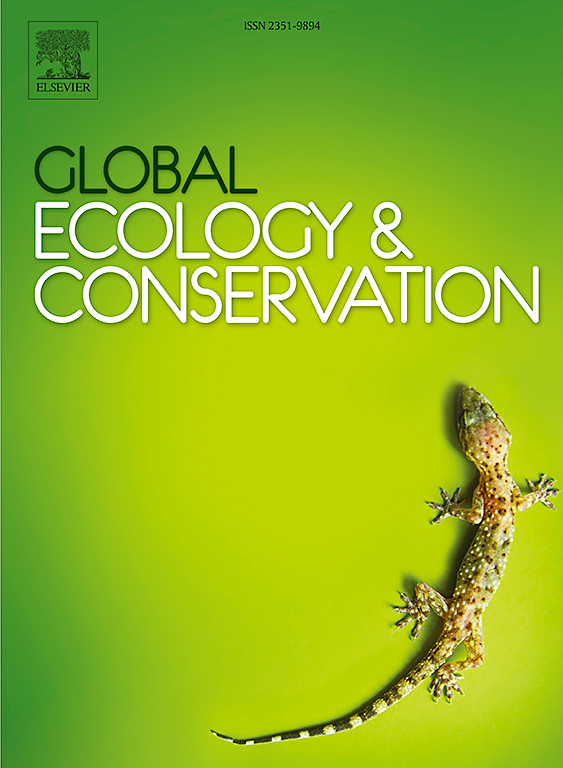揭示滨海海岛城市公园植物多样性的多因子驱动机制——以福建省为例
IF 3.4
2区 环境科学与生态学
Q1 BIODIVERSITY CONSERVATION
引用次数: 0
摘要
近年来快速的城市化进程造成了广泛的生态系统干扰,对城市生物多样性造成了巨大压力,特别是在沿海岛屿独特而脆弱的环境中。尽管如此,对岛屿城市公园植物多样性的研究仍然很少。为解决城市化带来的生态挑战,深入研究海岛城镇公园植物多样性及其驱动机制是亟待解决的科学问题。本研究以福建省4个岛屿的24个城市和城镇公园为研究对象,探讨植物多样性的空间格局及其潜在驱动因素。研究结果表明,沿海岛屿公园的植物多样性是由多种因素共同决定的。公园年龄与自然物种多样性呈显著正相关,支持遗产假说。较高的绿地比显著提高了物种丰富度,而增加的道路比降低了物种丰富度,但提高了物种均匀度。与海洋的距离显著增加了栽培物种的多样性。年日照时数具有双重影响:通过环境过滤降低物种均匀度,同时通过经济因素间接影响物种多样性。值得注意的是,公园面积对植物多样性没有显著影响,这可能是由于岛屿公园的面积相对较小或生境异质性较低。本研究为沿海岛屿城市和城镇公园的规划和管理提供了有价值的见解。主要建议包括优先保护具有重要历史意义的老公园,优化绿地布局,增强景观连通性,以及引入耐旱和耐光的本地植物物种以改善植物群落结构。未来的研究应结合长期监测和多学科方法,进一步探索人类活动和气候变化对植物多样性的动态影响,最终为类似地区的生态管理和生物多样性保护提供支持。本文章由计算机程序翻译,如有差异,请以英文原文为准。
Unveiling multifactorial driving mechanisms of plant diversity in coastal island urban parks: A case in Fujian Province, China
The rapid process of urbanization in recent years has caused extensive ecosystem disturbances, imposing substantial pressure on urban biodiversity, especially within the unique and fragile environments of coastal islands. Despite this, research on plant diversity in island city parks remains scarce. Addressing the ecological challenges brought about by urbanization necessitates an in-depth investigation into plant diversity and its driving mechanisms in urban and town parks on coastal islands, which represents a pressing scientific issue. This study examines 24 urban and town parks across four islands in Fujian Province, China, aiming to elucidate the spatial patterns of plant diversity and identify its potential driving factors. The findings reveal that plant diversity in coastal island parks is shaped by a combination of factors. Park age was significantly positively correlated with spontaneous species diversity, supporting the legacy hypothesis. A higher green space ratio significantly enhanced species richness, whereas an increased road ratio reduced species richness but improved species evenness. Distance from the sea significantly increased the diversity of cultivated species. Annual sunshine hours had a dual influence: they decreased species evenness via environmental filtering while indirectly affecting diversity through economic factors. Notably, park area exhibited no significant impact on plant diversity, likely due to the relatively small size or low habitat heterogeneity of island parks. This study offers valuable insights for the planning and management of urban and town parks on coastal islands. Key recommendations include prioritizing the preservation of historically significant older parks, optimizing green space layout, enhancing landscape connectivity, and incorporating drought- and light-tolerant native plant species to improve plant community structures. Future studies should integrate long-term monitoring and multidisciplinary approaches to further explore the dynamic effects of human activities and climate change on plant diversity, ultimately supporting ecological management and biodiversity conservation in similar regions.
求助全文
通过发布文献求助,成功后即可免费获取论文全文。
去求助
来源期刊

Global Ecology and Conservation
Agricultural and Biological Sciences-Ecology, Evolution, Behavior and Systematics
CiteScore
8.10
自引率
5.00%
发文量
346
审稿时长
83 days
期刊介绍:
Global Ecology and Conservation is a peer-reviewed, open-access journal covering all sub-disciplines of ecological and conservation science: from theory to practice, from molecules to ecosystems, from regional to global. The fields covered include: organismal, population, community, and ecosystem ecology; physiological, evolutionary, and behavioral ecology; and conservation science.
 求助内容:
求助内容: 应助结果提醒方式:
应助结果提醒方式:


